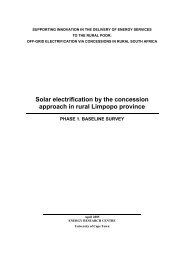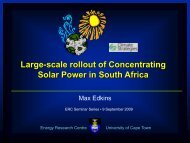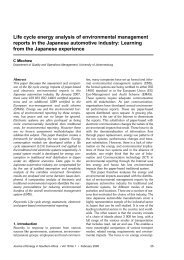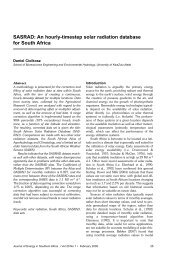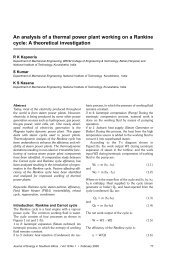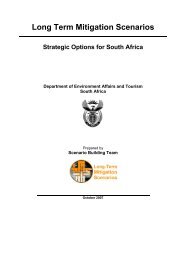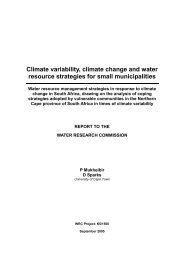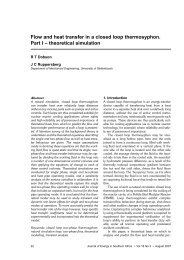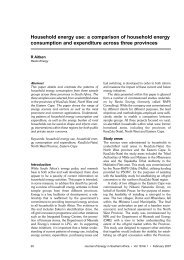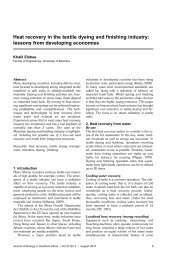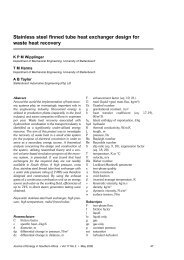(Ed) 2006. Energy policies for sustainable development in South Africa
(Ed) 2006. Energy policies for sustainable development in South Africa
(Ed) 2006. Energy policies for sustainable development in South Africa
Create successful ePaper yourself
Turn your PDF publications into a flip-book with our unique Google optimized e-Paper software.
16 ENERGY POLICIES FOR SUSTAINABLE DEVELOPMENT IN SOUTH AFRICA<br />
efficiency improvements are expected with oil-powered fuel cell technologies and with gaspowered<br />
technologies with improved turb<strong>in</strong>e systems and fuel cells.<br />
2.3.2.2 <strong>Energy</strong> efficiency technologies<br />
There is room <strong>for</strong> significant improvement <strong>in</strong> energy efficiency <strong>in</strong> <strong>South</strong> <strong>Africa</strong>, especially <strong>in</strong><br />
the power and <strong>in</strong>dustrial sectors, but also <strong>in</strong> the household sector. However, major policy<br />
changes will be needed to achieve these ga<strong>in</strong>s. The changes would have to be a<br />
comb<strong>in</strong>ation of regulatory and market-based <strong>policies</strong> and <strong>in</strong>stitutional changes. At present<br />
the NER, along with Eskom, has embarked on load management and demand-side<br />
management programmes <strong>in</strong> the residential, <strong>in</strong>dustrial and commercial sectors, aim<strong>in</strong>g to<br />
achieve ga<strong>in</strong>s between 1000 MW and 3000 MW by 2010.<br />
2.3.2.3 Renewable energy technologies<br />
Compared to the total energy used, the usage of renewables is very small, but the<br />
government <strong>in</strong>tends to <strong>in</strong>crease it to about 14% by 2014 (Mlambo-Ngcuka 2003). A White<br />
Paper on renewable energy was published <strong>in</strong> 2003.<br />
2.3.3 Comply<strong>in</strong>g with environmental regulations<br />
Because of <strong>South</strong> <strong>Africa</strong>’s extensive use of coal and petroleum fuels, adverse impacts on<br />
both the local and global environment are significant.<br />
The extraction of large quantities of coal leads to noticeable environmental impacts and<br />
‘upstream’ emissions. For example, most of the methane released from the <strong>South</strong> <strong>Africa</strong>n<br />
energy sector is as a result of coal m<strong>in</strong><strong>in</strong>g. Land scarr<strong>in</strong>g is caused by pit digg<strong>in</strong>g and<br />
discard dump<strong>in</strong>g. Discard dumps are prone to spontaneous combustion, water pollution<br />
from run-off, and <strong>in</strong>creased surround<strong>in</strong>g particulate concentrations. The conversion of coal<br />
to petroleum products is about 40% efficient, result<strong>in</strong>g <strong>in</strong> significant emissions. Coal power<br />
generation is relatively efficient, operat<strong>in</strong>g at about 35%. Power stations produce large<br />
amounts of CO 2 , SO 2 , NO x and ash, although stacks that penetrate the <strong>in</strong>version layers,<br />
and effective ESP particulate controls, m<strong>in</strong>imise impacts of all but the CO 2 emissions.<br />
<strong>South</strong> <strong>Africa</strong> is presently draft<strong>in</strong>g stricter air quality standards. The country is a signatory to<br />
the United Nations Framework Convention on Climate Change (UNFCCC) and at the<br />
same time it is <strong>Africa</strong>’s highest emitter of greenhouse gases. It is very likely that targets will<br />
be imposed on <strong>South</strong> <strong>Africa</strong> as soon as these apply to develop<strong>in</strong>g countries. Comply<strong>in</strong>g<br />
with such obligations, both local and global, will be expensive. To ensure <strong>susta<strong>in</strong>able</strong><br />
<strong>development</strong>, this should not be done at the expense of the country’s socio-economic<br />
<strong>development</strong>.<br />
2.3.4 <strong>Energy</strong> <strong>in</strong>tegration and security <strong>in</strong> <strong>Africa</strong><br />
<strong>South</strong> <strong>Africa</strong> is a member of the SAPP – made up of the different power utilities <strong>in</strong><br />
<strong>South</strong>ern <strong>Africa</strong>, with a secretariat <strong>in</strong> Harare, Zimbabwe. SAPP started operations <strong>in</strong> 2002,<br />
with the aim of optimis<strong>in</strong>g the use of electricity <strong>in</strong> the region. <strong>South</strong> <strong>Africa</strong> has the biggest<br />
electricity utility <strong>in</strong> SAPP, and its future will be affected by SAPP’s activities. Eskom is<br />
currently work<strong>in</strong>g <strong>in</strong> 39 <strong>Africa</strong>n countries, confirm<strong>in</strong>g <strong>South</strong> <strong>Africa</strong>’s importance <strong>for</strong> energy<br />
<strong>in</strong>tegration <strong>in</strong> the cont<strong>in</strong>ent.<br />
As an example of regional energy cooperation, <strong>South</strong> <strong>Africa</strong> has embarked on diversify<strong>in</strong>g<br />
its energy supply base and reduc<strong>in</strong>g its reliance on the coal that accounts <strong>for</strong> 75% of its<br />
energy supply. Substitution of coal <strong>for</strong> natural gas from Mozambique is one such measure:<br />
full operation of this system started <strong>in</strong> early 2004. It is <strong>in</strong>tended to use the gas to produce<br />
power <strong>in</strong> comb<strong>in</strong>ed cycles. Work with Namibia to develop its natural gas potential is also




